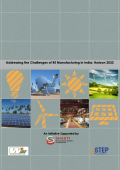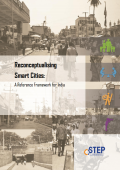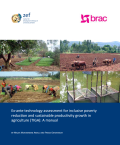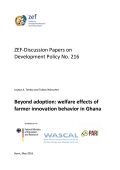
This study comprehensively examines the manufacturing supply chain of different components used in RE (renewable energy) systems, especially wind and solar technology, in India. Over the past one and half years, around 90 interviews were conducted across the solar and wind industry comprising manufacturers, developers, system integrators, academicians and policy makers. A sourcing strategy for these components has been identified based on macroeconomic criteria, material and resource constraints, techno-economic feasibility and international market dynamics. The report also proposes necessary policy and regulatory interventions to expand the supply of RE and create a demand-side pull.

The Government of India (GoI) initiated the "100 Smart Cities Mission" in 2014. This has triggered deliberations across the country on the concept of smart cities, the need and the orientation of the Mission in the context of India’s present urbanisation scenario. The concept of a "Smart City" is a relatively new phenomenon in India. This report is a step towards synthesising various aspects related to smart cities that has led to the formation of a proposed Reference Framework by CSTEP, for the Smart Cities Mission in India. The report is expected to guide policy makers and urban practitioners in making critical decisions, in an accountable manner and spirit, which will truly make Indian cities smart.
The report begins by carving out the following scope, for India:

Over the past decade, India’s cities have been witnessing an increasing trend in motorization with deteriorating air quality, and there have been calls to promote public transport as a way out of this gridlock. It is in this context that electric buses can play a positive role, as there are several benefits associated with the shift from conventional diesel buses to electric buses in terms of reduction in local pollution, noise, and fuel consumption. In spite of the many positive benefits related to the electric bus technology, certain challenges remain. Primary among these are costs and safety concerns. Currently, the Electric Vehicle (EV) technology is associated with significant capital costs, with the battery component constituting about half of the total manufacturing costs. Safety is yet another important parameter, and the biggest concern is that of a fire hazard. However, with a good Battery Management System (BMS), rigorous implementation of standard operating procedures, and customization of the bus fleet, both safety and cost aspects can be effectively addressed.

The manual presented here is based on the experience and draw out the collected lessons learnt with regard to the design and implementation of TIGA project in the South Asia and Sub-Saharan Africa. As such, this builds on and expands existing guidelines and documentation for agricultural technology assessment. It adds the perspective of technology assessment of including the cross section of segments of the rural poor characterized by varying degrees of overlapping human capabilities and agro-ecological potentials rather than the technology-driven approaches that tend to favor those with better adoption capabilities. The manual also gives the reader a well-documented experience of bottom-up approach for technology assessment.

With numerous challenges hindering smallholders’ adoption of externally developed technologies, it is often argued that farmer innovation can play an essential role in rural livelihoods. Yet a rigorous assessment of the impact of farmer innovation is lacking. We address this issue by analysing the effect of farmer innovation on household welfare, measured by income, consumption expenditure, and food security. Using household survey data from northern Ghana and applying endogenous switching regression, we find that farmer innovation significantly increases household income and consumption expenditure for innovators. It also contributes significantly to the reduction of food insecurity among innovative households by increasing household food consumption expenditure, decreasing the duration of food shortage, and reducing the severity of hunger. However, we find that the positive productivity and income effects of farmer innovation do not significantly translate into nutritious diet, measured by household dietary diversity.
